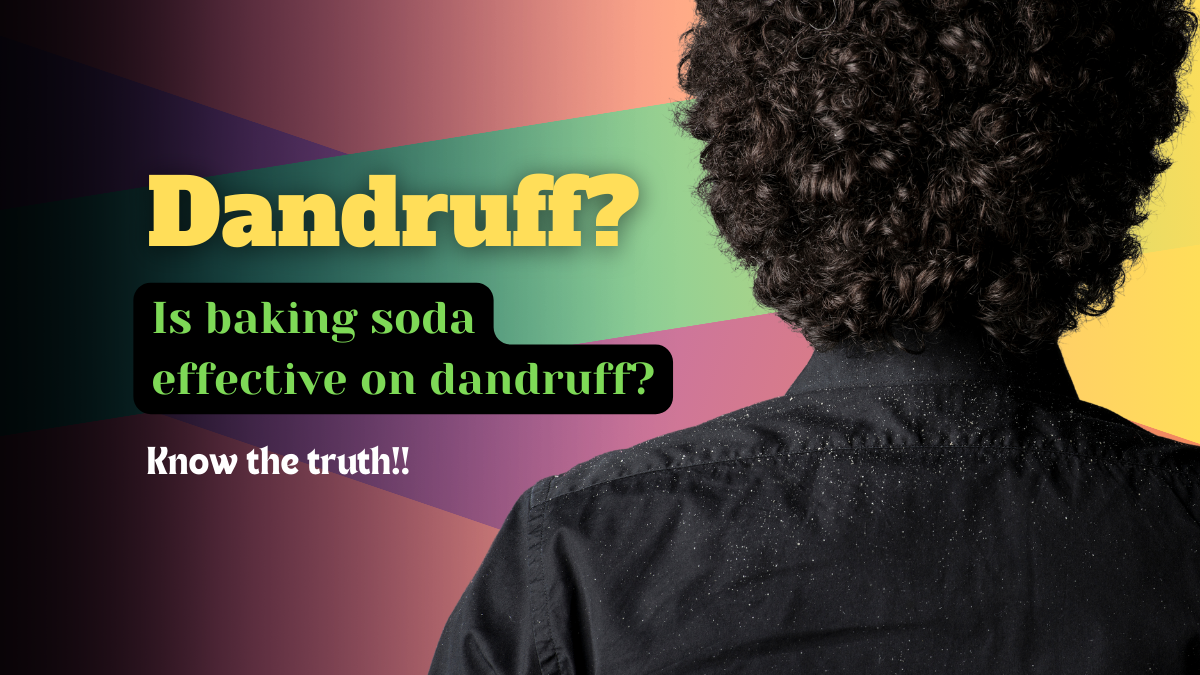Dealing with dandruff is a common concern and ignoring it can cause damage to your scalp and hair. This is why many people turn to home remedies as the solution, and one popular contender is baking soda.
Despite its popularity, it is important to note that there is a lack of scientific research supporting the use of baking soda for dandruff. In fact, there are even reports suggesting possible damage to hair and skin.
However, don’t be afraid! With careful use and the right balance, baking soda can still prove effective in dealing with dandruff. Read this exclusive article today to uncover the secrets of how baking soda can work wonders on dandruff and know the best ways to use it.
Can baking soda really deal with dandruff?
The effectiveness of baking soda in treating dandruff remains a mystery, with limited research shedding light on the topic. However, a notable 2013 study indicates the potential of baking soda, demonstrating its anti-fungal properties.
Adding to the intrigue, a 2005 study of 31 individuals with psoriasis showed that bathing with baking soda reduced itching and burning.
Making the connection between these findings, one can speculate that the antifungal nature of baking soda may provide relief from dandruff, a fungal infection. Still, the main thing is caution.
Dive deeper into this exploration to highlight the potential benefits and important considerations when considering baking soda as your dandruff treatment.
Baking Soda: Friend or Foe for Your Hair and Scalp?
Burning Question: Can baking soda do more harm than good to your hair and scalp?
Highlighting the evidence, a 2014 study highlighted pH levels as important in maintaining healthy hair. The average pH of the scalp hovers around 5.5, while the hair shaft leans toward 3.67. Achieving a harmonious balance between these pH levels is paramount to optimal hair health.
Add baking soda with a pH level of 9. This discrepancy creates concern. High pH can cause a number of problems when incorporated into your hair care routine, including:
- Damage to cuticles: The protective layers of your hair can be at risk.
- Frizz: Say goodbye to sleek and manageable locks.
- Hair loss: An unwanted consequence of pH imbalance.
- Burning sensation: Unpleasant sensations on the skin.
- Dry Hair: Lack of moisture can cause your hair to become dry.
Baking Soda vs. Baking Powder – Know the Difference!
Ever wondered about the kitchen wizards behind your baked delights? Enter the dynamic duo: baking soda and baking powder.
They may share the same habitat in your kitchen, rock a similar snowy appearance, and boast interchangeable names, but make no mistake—they’ve got distinct roles in the baking realm.
Here’s the breakdown:
Baking Soda (aka Sodium Bicarbonate): This naturally alkaline champion waits for its moment, activated by the tag team of liquid and an acid. It’s the powerhouse behind many a rise in your favorite baked treats.
Baking Powder: This culinary sorcerer carries sodium bicarbonate too, but it’s got a sidekick—an acid companion. Unlike baking soda, this magical duo only springs to life when they meet the enchantment of a liquid.
So, next time you’re in the kitchen, keep this culinary chemistry in mind and let your baked creations soar to new heights!
3 Creative Ways to Harness Baking Soda for Dandruff Relief
Ditch the dandruff drama with these five easy and effective methods of using baking soda. But here’s a crucial tip: avoid applying baking soda solo on your hair or skin—it might do more harm than good. The key is to team it up with other natural allies. Let’s dive into the magic of baking soda for dandruff:
1. Olive Oil and Baking Soda
Say goodbye to dirt, excess oil, and fungal foes! Baking soda swoops in to cleanse the scalp and hair, while olive oil brings the moisturizing magic to the party. The added bonus? Egg yolk steps in to condition your locks and promote hair growth.
Ingredients:
- 1 tsp baking soda
- 1 egg yolk
- 1 teaspoon olive oil
How to Apply:
- Gently warm olive oil in a bowl.
- Mix it with egg yolk and baking soda.
- Apply the mixture to your hair and scalp, leaving it on for 20 to 25 minutes.
- Rinse with lukewarm water, followed by a refreshing splash of cold water.
- If the egg aroma lingers, a mild herbal shampoo can come to the rescue.
Repeat this fantastic hair pack twice a week for a flourishing, dandruff-free crown!
2. Baking Soda and Coconut Oil
Embark on a journey to luscious locks with the dynamic duo of baking soda and coconut oil. This power-packed combo dives deep into your hair roots, bidding farewell to protein deficiencies.
Say goodbye to dryness and scalp itching as this magical blend works wonders in preventing dandruff. And there’s more – the honey in this concoction doubles as a natural conditioner, leaving your hair with a radiant shine.
Ingredients:
- 1 tsp baking soda
- 1 teaspoon coconut oil
- 1 tsp honey
How to Apply:
- Create a blissful blend by mixing oil, honey, and baking soda in a bowl.
- Apply this divine mixture generously on your scalp and hair.
- Let the magic unfold for 20 to 25 minutes.
- Rinse your hair with a mild shampoo for a perfect finishing touch.
Transform your hair care routine with this luxurious treatment, and watch your tresses revel in the goodness of baking soda, coconut oil, and honey!
3. Lemon Juice and Baking Soda
Say farewell to dandruff with the invigorating combination of lemon juice and baking soda. Follow these steps for a refreshing and effective treatment:
Ingredients:
- 2 tablespoons of baking soda
- 1 tablespoon of freshly squeezed lemon juice
Instructions:
Create the Mixture:
In a bowl, combine 2 tablespoons of baking soda with 1 tablespoon of freshly squeezed lemon juice. Mix well to form a smooth paste.
- Application:
- Dampen your hair slightly, ensuring it is not soaking wet.
- Section your hair to facilitate even application.
- Gently massage the lemon juice and baking soda mixture onto your scalp, focusing on areas with dandruff. Be cautious not to be too abrasive.
Leave it on:
Allow the mixture to sit on your scalp for about 5 to 10 minutes. This gives the ingredients time to work their magic.
Rinse thoroughly:
Rinse your hair and scalp thoroughly with lukewarm water. Ensure there is no residue left.
Follow with Shampoo:
If you wish, you can follow up with your regular shampoo to eliminate any remaining traces of the mixture. Use a mild, dandruff-friendly shampoo for added effectiveness.
Condition(Optional):
Condition your hair as usual if needed. However, it’s advisable to focus the conditioning product on the lengths and ends, avoiding the scalp.
Frequency:
Incorporate this treatment into your hair care routine once a week initially, and adjust as needed based on your results.
The acidity of lemon juice helps balance the scalp’s pH, while baking soda exfoliates and removes excess oil, making this duo a dynamic team against dandruff.
Remember to monitor your scalp’s response and discontinue use if irritation occurs. Enjoy a zestier, dandruff-free hair journey with this natural remedy!
Unlock the full potential of baking soda by being mindful of the quantity you use. Your well-being is our priority, so if you encounter any discomfort, don’t hesitate to reach out to a doctor.
For persistent dandruff concerns, tapping into expert advice is the key to a healthy scalp.

